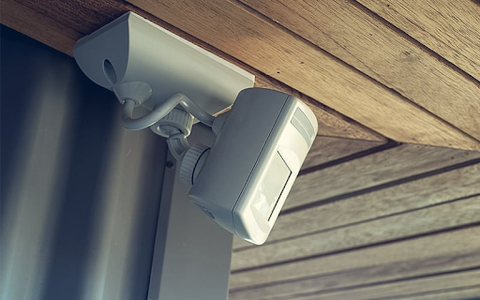Security cameras appear to be a good idea at first, but you quickly learn that they are impossible to monitor at all times. There's a reason why some organizations employ security personnel who are only responsible for staring at the CCTV system. Unless they have motion-detector cameras, they might miss something if they glance away.
For the typical individual, motion detection cameras make video monitoring more lifelike. They save you a lot of time staring at a screen by only informing you when something happens. Here are a few reasons why motion-detecting cameras are necessary. Let's get started.
What Is a Motion Detector Camera, and How Does It Work?

Credit: SafeWise
A motion detection camera is a security camera that activates only when it detects movement. This security camera does not capture footage throughout the day; rather, it records only when its motion sensor is triggered.
Built-in sensors in motion sensor security cameras keep an eye on the field of view for any movement. It will begin recording footage as soon as any suspicious activity is identified in the motion zones.
Benefits of Having a Motion Detector Camera
These are the 6 benefits of having motion detector cameras:
1) Better Protection

Credit: Axis Communication
When you compare the features of a non-motion and a motion detection camera, you'll see that the motion camera gives far more security. Whether you want to safeguard your house, business, or office, a motion camera is the finest alternative. You can always check on the premises to see what happened while you were away.
2) Extended Recording Time

Credit: ario
You can extend the recording period with the help of motion detection recording. This is because records are only made when there are movements. It does not record continually 24 hours a day, seven days a week. This saves video storage space.
One of the main reasons why many people prefer motion detection cameras to most security cameras is because of this.
3) Detection of Rodents and Pests

Credit: Pest Control Technology
Motion detection in security cameras does not have to be limited to humans. Smaller animals, such as rodents, can also be detected by motion sensors. So, if you're dealing with a pest problem, advanced motion detection cameras can help with their color night vision.
Once you know what pests you're dealing with, you can devise strategies to keep them out of both the interior and exterior of your home. Pest control businesses can use the video feeds to find out the best ways to get rid of these pests.
4) You Can Monitor Your House From Anywhere

Credit: Security Alarm
You'll feel at ease every time you leave your house because you'll know you can check on it at any time. A good security camera comes with applications, allowing you to see what's going on in your house from anywhere.
When you link the camera's app to your phone, computer, laptop, or tablet, you'll receive alerts and notifications whenever the motion sensor of your security camera detects unusual movement.
5) Aids in Faster Response to Emergencies

Credit: iStock
Smoke and fire detectors are excellent for preventing fires, but motion-activated cameras can help you detect other types of emergencies. Motion detectors can be triggered by a burst pipe or spilling water, for example. You may be able to avoid serious flooding or further damage to your house due to the quick response of motion detector cameras.
6) Accelerate the Post-Investigation Procedure

Credit: FoneArena
Because recordings only include the time frames when events occur, this will assist reduce the amount of time spent reviewing the tape.

Types of Motion Detector Cameras
Different types of sensors employ various technologies to achieve the same goal: movement detection. The most frequent types of detectors are as follows:
1) Passive Infrared(PIR)

Credit: sensinova
To measure body heat, a passive infrared sensor searches for temperature fluctuations (infrared energy). This is the most extensively utilized motion sensor in home security systems. When you launch your system, the motion sensors are activated, alerting you to any potential threats.
Once the PIR motion sensor has warmed up, it can detect heat and movement in the immediate vicinity, forming a protective "grid." If a moving object blocks too many grid zones, the infrared sensor will sound an alarm.
2) Microwave Occupy Sensor

Credit: Blackt Electrotech
Some motion sensor cameras can also be equipped with microwave technology, which employs microwave pulses instead of infrared waves of light. Microwave Occupy Sensors are a technology that is believed to be active. These sensors have a longer range, but they're less popular because they're more expensive and susceptible to electrical interference.
3) Dual Technology Motion Sensors

Credit: ZMR-Technology Distribution
To limit the risk of false alarms, Dual Technology Motion Sensors integrate passive infrared and microwave sensors. Dual technology motion systems require both sensors to be triggered before the sensor alarm is activated.
4) Area Reflective Type Sensors

Credit: SICK
In order to secure an area, these sensors employ LEDs to emit infrared rays. To determine if persons or things have entered a restricted area, Area Reflective Type Sensors calculate the distance between them and the detector.
5) Vibration Sensors

Credit: RDI Technologies
One of the most cost-effective sensors is Vibration Sensors. A switch activates vibration sensors, which send out a vibration to detect motion.
Summary
It is critical to have safeguards in place to protect your home. However, in the event that your home is broken into, you must ensure that your valuables are kept safe. Travah presents to you our diversion safes. Your valuables will be kept safe from harm's way with our state-of-the-art diversion safes.

